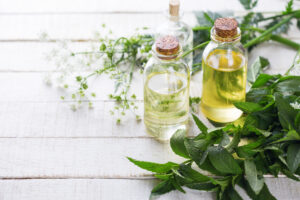Some shocking facts about sunscreen.
It’s that wonderful time of year when the whole summer is ahead of you. The downside is that, in most places, this can also mean too much sun. The UVA and UVB rays damage skin, causing accelerated again and skin cancers. Most of us reach for the protection of a sunscreen, but unfortunately, sunscreen isn’t risk free either.
Industrially produced sunscreens are made from vats of complex chemicals, and Consumer Reports and Which? discovered that some of them don’t do what they say on the tin, failing tests evaluating their ability to block UVA and UVB.
While there are rigorous safety tests for all skin products, companies engineer creams to pass the tests, which is not always the same as protecting you from harmful ingredients, or even finding out what the long-term effects of use are. To make up your mind about how best to protect yourself from the sun, it helps to know how these things work.
Essentially there are two different types of sunscreen; those creating a physical barrier and those which create a chemical block.
Physical sunscreens
Physical sunscreens create a film over your skin that deflects and blocks the harmful rays. Ingredients include inorganic (mineral) compounds such as titanium dioxide and zinc oxide.
To be effective, you need to slather on a thick layer, which may be greasy and messy and will leave a white sheen over your skin. It can also be difficult to remove from clothing. However, it protects your skin from a broad spectrum of light and works as soon as it’s applied.
Physical sunscreens are much better for sensitive skins and anyone with a skin condition that reacts to sunlight.
Your skin is brilliant at keeping out pretty much everything, however, some physical sunscreens were manufactured using nanoparticles, which were then found in the blood of some test subjects. This claim was later refuted, but many manufacturers phased out the use of nanoparticles anyway.
The major disadvantage of physical barrier sunscreens is that the minute you do anything like swim, or sweat, or move, you’ll need to apply another layer.
Chemical sunscreens
Chemical sunscreens function on a whole different level. The dermal level. They will spread on more easily and all but disappear as they penetrate the skin. Many producers add other ingredients to moisturise or colour the skin.
Unfortunately, the chemistry behind these products means that they need to cook into your skin before they’re effective, so will not protect you for the first twenty minutes of use. That does mean you can apply them ahead of time. If you happen to have damaged skin, you may find that chemical sunscreens itch or sting, as they would if they got into your eyes, so you may not want to! The higher the SPF ratings, the more of an irritant they are.
Because the products are UV activated, they will ‘wear off’ more quickly if you are in direct sun, requiring reapplication. Chemical sun creams to nothing to deflect the sun’s rays, so skin may also overheat, which can exacerbate brown spots on older skin.
Before applying these products, you might want to know a few things about some of the common ingredients.
Oxybenzone: a penetration enhancer that undergoes a chemical reaction when exposed to UV radiation, it can cause eczema like reactions, it’s also been linked to hormonal disruption in rat studies and in large doses, and experts agree more research is needed. It also damages coral reefs.
Octinoxate: easily absorbed by the skin, it’s been linked to hormone disruption and concerns have been raised about premature ageing of the skin.
Retinyl palmitate: basically vitamin A, it’s supposed to protect the skin from premature ageing, however when in contact with UV radiation it can break down and produce cell damaging free radicals associated with cancer.
Homosalate: another skin penetrating chemical that has the unfortunate habit of accumulating in our bodies faster than we can expel it, reaching poisonous level amongst habitual users.
Octocrylene: another free radical producer, and an environmental polluter to boot.
Paraben Preservatives: can provoke allergic reactions and are linked to cancer.
It is important to remember that while some sunscreens contain worrying ingredients, 5 episodes of serious sun burn before the age of twenty can increase your risk of a serious melanoma by 80%. So, if having read this, you decide that you’d still rather use sunscreen than risk skin cancer, be sure to read the labels before and wash with soap afterwards.
If you decide not to slather yourself with a protective layer, make sure you cover up with long sleeves and a hat instead.
Finally, you could try making your own sunblock, which is much easier than you might think and, made once or twice a year, requires no preservatives. I’m off to make a batch!




